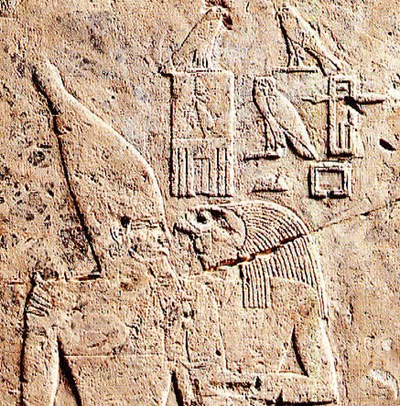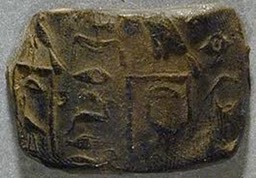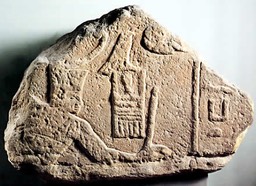The 3rd Dynasty follows a period when the country was divided into a Northern and a Southern kingdom and firmly reestablished the central authority over the entire country. The architectural achievements of this dynasty stress its pivotal role in the transition of the Early Dynastic Period into the Old Kingdom.
As was the case with the 2nd Dynasty, however, establishing the chronology of the 3rd Dynasty is somewhat problematic. This has the following reasons:
- Except for Huni, who is accepted to have been the dynasty's last king, the actual monuments of the 3rd Dynasty kings mention their Horus-names whereas the later king-lists are based on what is assumed to be their birth names (nomen).
- The kinglists name kings that seem to be unattested by archaeological sources. It thus becomes necessary to match the names of the 3rd Dynasty monuments with those of the king-lists.
- The Turin King-list has placed Nebka at the head of the dynasty, before Djoser (Horus Netjerikhet). Manetho has also placed a king before Djoser as the founder of the dynasty. Other kinglists do not mention Nebka at all, making Djoser the founder of the Dynasty. According to the Papyrus Westcar, which lists some of Kheops' predecessors, Nebka must be placed between somewhere Djoser and Huni.
Although most kinglists give five kings that can be placed in this dynasty, there are some inconsistencies involving the 4th king of the list. This king is referred to as Hudjefa by the Turin Canon, a reference normally used for kings whose names were deliberately or accidentally damaged in the original source(s) consulted by the composer or copyists of the kinglist. If the destruction of the name was deliberate, then this may be seen as an indication of some dynastic troubles.
The other king-lists, however, record the name Sedjes or Neferkare as the 4th king of the Dynasty. This can mean that either all three names refer to the same or to different kings. If all these names, including Hudjefa, refer to the same king, it is hard to explain why one king would be referred to as Sedjes and as Neferkare. If they refer to different kings then the Hudjefa of the Turin Canon refers to Sedjes, to Neferkare or to a third, unknown king. In this case, however, it would be hard to explain why the Turin Canon only notes 5 kings instead of 6 or 7. - Manetho, through the different copies of his original work, lists even more kings in the 3rd dynasty and credits it with a total duration of over 200 years. Both the number of kings and the dynasties duration are generally accepted to have been largely exaggerated. However, the higher number of kings given by Manetho does suggest that the number of 5 kings mentioned in the older king-lists may be too low.
The builder of the famous Step Pyramid at Saqqara is identified throughout his complex as Horus Netjerikhet. An inscription left by the 19th Dynasty prince Khaemwaset, the famous son of Ramesses II, in the complex crediting the building to Djoser, has allowed us to equate Horus Netjerikhet with Djoser(-Ti) of the king-lists.
The Step Pyramid of Netjerikhet is the oldest known building to be completely made of stone.
At least two other buildings, somewhat similar to Netjerikhet's Step-Pyramid, have been started but left unfinished during the 3rd Dynasty as well: the buried pyramid at Saqqara and the layered pyramid at Zawiyet el-Aryan. Based on archaeological and architectural evidence, it is safe to say that both monuments were built after Netjerikhet's. In the buried pyramid of Saqqara, the oldest of the two, the Horus-name of Sekhemkhet has been found. If an inscription found in this pyramid may be interpreted as Sekhemkhet's Nebti-name, then Sekhemkhet may be equated to Djoser-Teti, the successor of Djoser (Netjerikhet) in the kinglists. This interpretation is supported by the style and location of his pyramid and by the mention of Imhotep, the architect of Netjerikhet's pyramid, in an inscription in Sekhemkhet's monument.
In the pyramid of Zawiyet el-Aryan, no royal name has been found. In a tomb located in a nearby private cemetery, however, the Horus-name of Khaba was found. This has led archaeologists to believe that the layered pyramid of Zawiyet el-Aryan was built by Horus Khaba. This king would then come after Sekhemkhet but before Huni, which could equate him with the fourth position in the king-lists: king Hudjefa.
Two other kings, known only through their Horus-names, have belonged to the 3rd Dynasty as well: Horus Sanakht and Horus Qa-Hedjet.
Neither king can be placed with certainty. It has been suggested that Sanakht may have been the Horus-name of Nebka, but the sole argument that supports the identification of Sanakht as Nebka is a source found in the Sinai that mentions Horus-name Sanakht and the sign ka that could be interpreted as part of the nomen of the king. The ka sign, however, is part of a word that spells mefkat, meaning 'turquoise', the main mineral the Egyptians were after in the Sinai.
If Sanakht can indeed be equated to Nebka, then it is clear that the Turin King-list has mistakenly placed Nebka before Djoser (Netjerikhet), as the archaeological record points to Netjerikhet having been a predecessor of Sanakht.

Horus embraces Qa-Hedjet.
Source: Allen e.a., L'art égyptien au temps des pyramides, 1999, p. 155
The identification of Qa-Hejdet with any of the kings in the King-lists remains rather problematic.
In view of the sources it may be tempting to equate the Horus Qa-Hedjet with Huni, the last king of the dynasty, particularly because the Horus-name of Huni is not known either. This equation, however, is purely hypothetical and not generally accepted among Egyptologists.
Regardless of our problems in identifying some of its kings, the single most important achievement of the 3rd Dynasty in the history of Ancient Egypt was the transition in architecture from wood and brick to natural stone. The building of the Step Pyramid complex for Horus Netjerikhet at Saqqara is a giant leap forward in technology and architecture. So great that it determined the general shape of Egyptian buildings for the millennia to come. Netjerikhet, under the name of Djoser, and even more his genius architect Imhotep, would remain renowned throughout Ancient Egypt's long history.
Eventhough Netjerikhet's immediate successors failed to continue the great building project of their ancestor, the 3rd Dynasty played a pivotal role in the transition from Early Dynastic Egypt into the Age of the Pyramids. This is why, in many history books, the 3rd Dynasty is placed at the start of the Old Kingdom and not at the end of the Early Dynastic Period. However, more and more Egyptologists are now inclined to include this dynasty in the Early Dynastic Period, because culturally it resembles the two first dynasties more than it does the following.
Click on the thumbnails below to learn more about the kings of the 3rd Dynasty.

